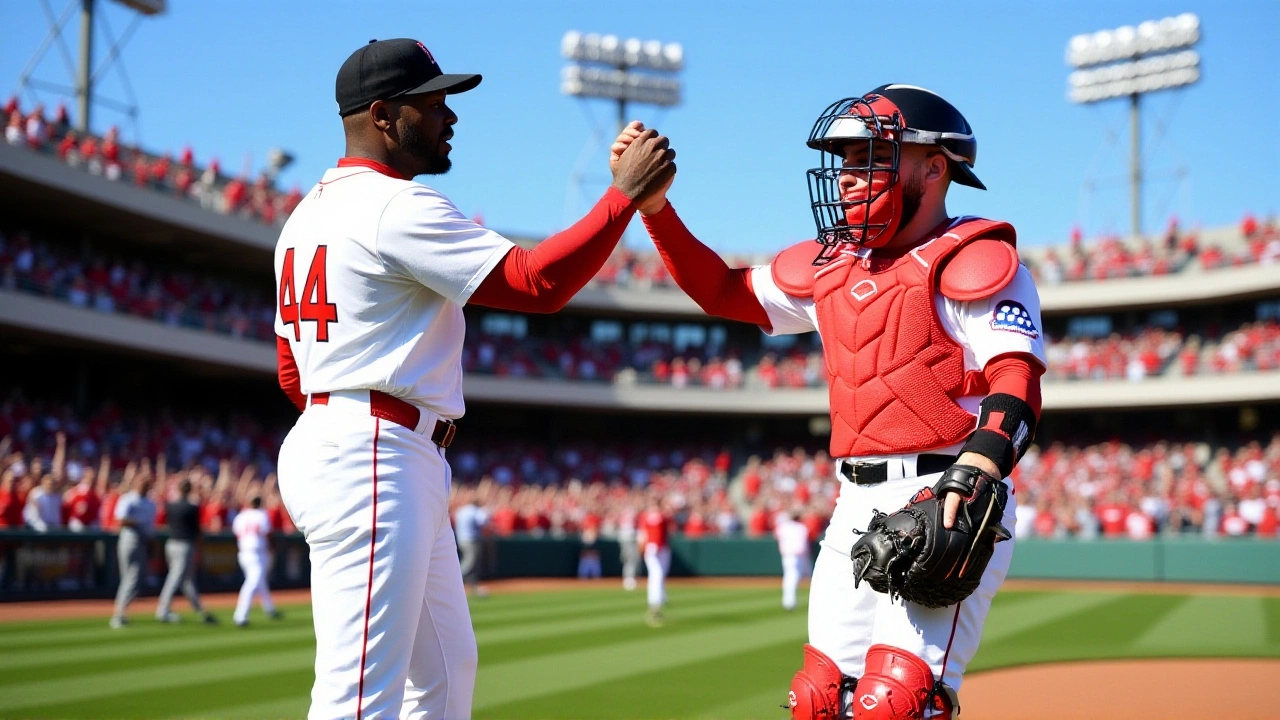When Aroldis Chapman, the hard‑throwing closer for the Boston Red Sox, stepped onto the mound on September 7, 2025, at Chase Field in Phoenix, he turned a routine save into baseball folklore.
Chapman entered the bottom of the ninth with Boston up 7‑4 against the Arizona Diamondbacks. Working with catcher Connor Narvey, he struck out four consecutive batters, a feat that can only happen when a catcher drops the third strike and the batter reaches first safely. The result? A four‑strikeout inning that lowered his ERA to a sparkling 0.98 and marked his 60th appearance of the season.
The Historic Fourth Strikeout Inning
Four‑strikeout innings are rarities even in the long history of Major League Baseball. The last time a Red Sox pitcher pulled it off was in 1992, and fewer than 30 instances have ever been recorded in the modern era. In Chapman’s case, the fourth strikeout came after a clean third‑strike drop‑catch by Narvey, allowing the batter to sprint to first before pocketing the next three outs.
Statistically, the inning was a marvel: 12 pitches, 11 of them swinging strikes, and a single wild pitch that never threatened a run. The Diamondbacks’ lineup—featuring sluggers like Christian Walker—couldn’t find a rhythm, and the crowd’s roar faded into a stunned silence as the final strikeout clipped the catcher’s glove.
Chapman's Season of Dominance
Beyond that single inning, Chapman’s 2025 campaign reads like a résumé for the Hall of Fame. He set a franchise record with Boston Red Sox by stringing together 16 consecutive hitless appearances, a stretch that began on May 28, 2025. During that run, he faced 46 batters without surrendering a hit and allowed just one earned run across 36 outings.
August earned him the American League Reliever of the Month award, thanks to a 0.88 ERA, 27 strikeouts, and a WHIP of 0.62. Even in his occasional rough patches—six hits and a walk over 6.1 innings in his final seven regular‑season outings—his velocity stayed in the high‑100s, with a spin rate that hovered around 2,500 rpm.
Reactions from Teammates and Opponents
"Aro’s fireball is like a freight train," said Boston shortstop Rafael Devers. "When he’s on, the whole dugout feels the pressure drop."
Diamondbacks manager Kirk Gibson was more measured: "We knew the risk coming in. Chapman’s delivery is rare—his fastball can sit at 101 mph with a spin that makes the batter’s eye roll. It’s not a surprise he got the four‑K.”

What the Feat Means for Boston’s Postseason
The timing couldn’t have been better. With the AL Wild Card spot on the line, Chapman’s confidence surged heading into the playoffs. Ten days later, on September 30, he locked down the save in Game 1 of the American League Wild Card Series Yankee Stadium against the New York Yankees.
In that game, Chapman unleashed a 101.2‑mph four‑seam fastball with a spin of 2,525 rpm to strike out Trent Grisham, sealing a 3‑1 victory. He did allow three singles to load the bases, but his ability to find the zone under pressure—10 of his 11 pitches over 100 mph after the bases were jammed—demonstrated why he’s the league’s most feared closer.
Looking Ahead: Chapman’s Role in the ALDS
Boston now faces the Houston Astros in the ALDS, and Chapman’s durability will be under the microscope. If his season is any indication, he can sustain a sub‑1.00 ERA deep into a series, provided he gets adequate rest between outings. The Red Sox front office has already hinted at a potential “closer‑by‑committee” approach if foul‑tips or lingering soreness arise, but the consensus among analysts is that Chapman remains the linchpin.
One thing is clear: a pitcher who can produce a four‑strikeout inning once is a once‑in‑a‑generation talent. For the Red Sox, that talent just turned the tide on a critical September night in Arizona, and the ripple effect will likely be felt all the way to Boston’s World Series hopes.
Key Facts
- Date of feat: September 7, 2025
- Location: Chase Field, Phoenix, AZ
- Outcome: Red Sox 7, Diamondbacks 4
- Chapman’s ERA after the inning: 0.98
- Four‑strikeout inning: first for a Red Sox pitcher since 1992

Frequently Asked Questions
How rare is a four‑strikeout inning in modern baseball?
A four‑strikeout inning usually occurs when a catcher drops a third strike, allowing the batter to reach base. Since 1900, fewer than 30 documented instances have happened in the major leagues, making Chapman's feat a headline‑worthy rarity.
What impact does this performance have on the Red Sox’s playoff outlook?
Closing games with such dominance boosts team confidence and solidifies Chapman’s role as the ace in high‑leverage situations. Boston’s bullpen now has a clear go‑to, which could be decisive in a tight ALDS against the Astros.
Did Chapman’s velocity change during the four‑strikeout inning?
Video analysis shows his fastball stayed in the high‑100 mph range, averaging 101.4 mph, while the spin rate remained above 2,500 rpm—exactly the same numbers he posted in August, indicating no dip in arm speed.
How did Diamondbacks fans react to the inning?
Fans were quieted mid‑game; social‑media clips captured a collective gasp as each strikeout followed. Post‑game, several Arizona supporters praised Chapman's skill, noting it was a “masterclass in velocity and control.”
What does this mean for Chapman’s contract negotiations?
A historic performance like a four‑strikeout inning adds leverage. Agents often cite rare achievements when discussing long‑term extensions, and Boston could look to lock him up through at least 2029 if they want to keep the elite closer.
